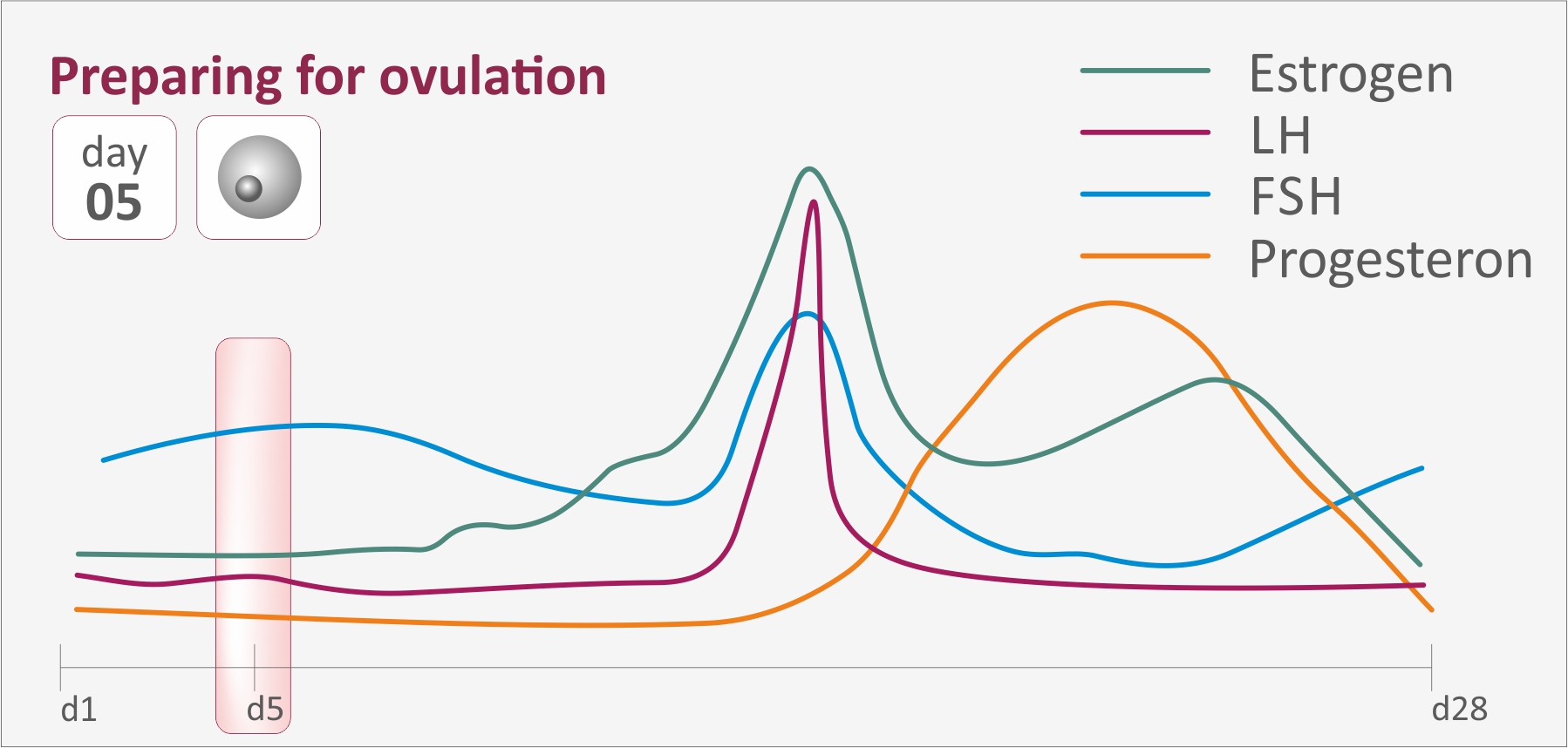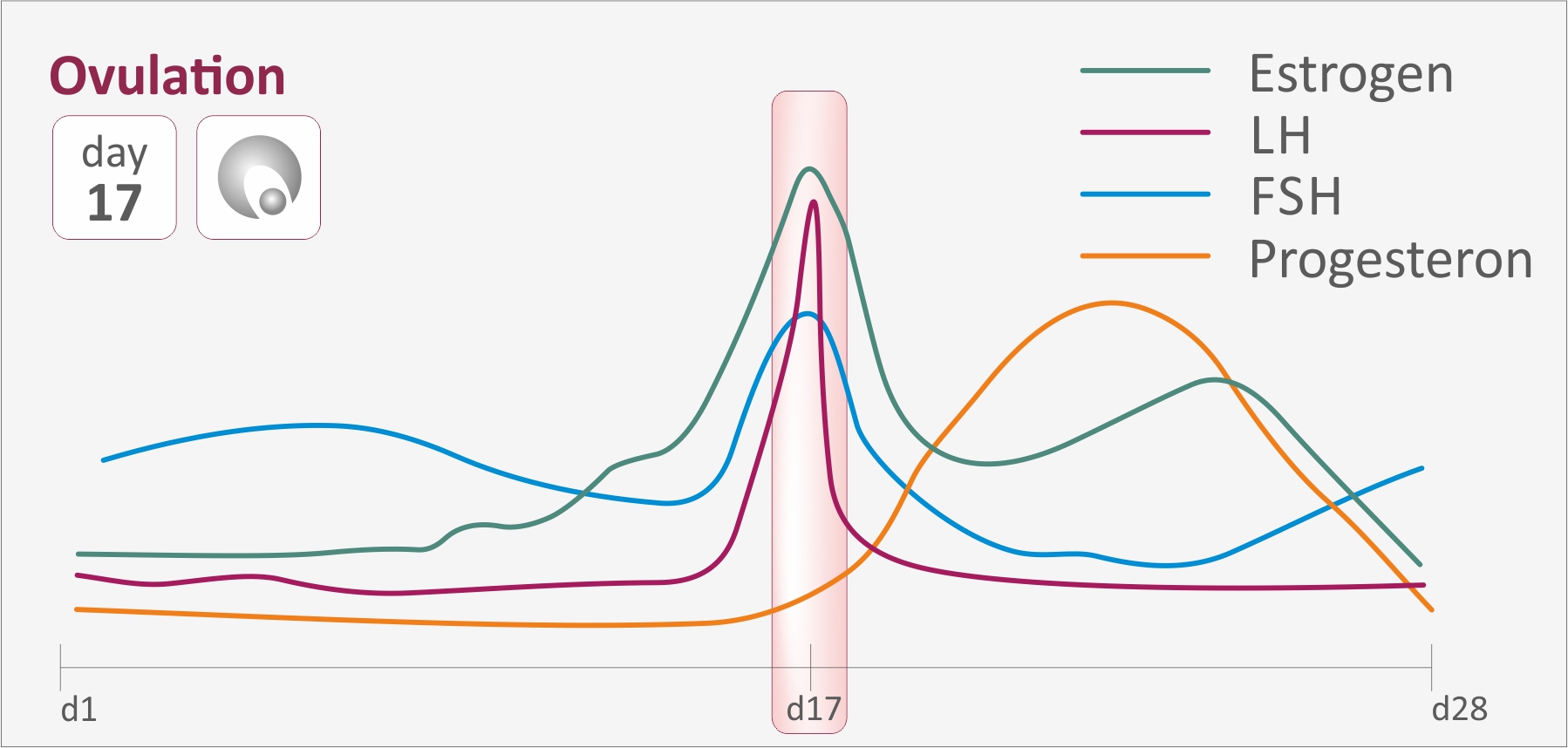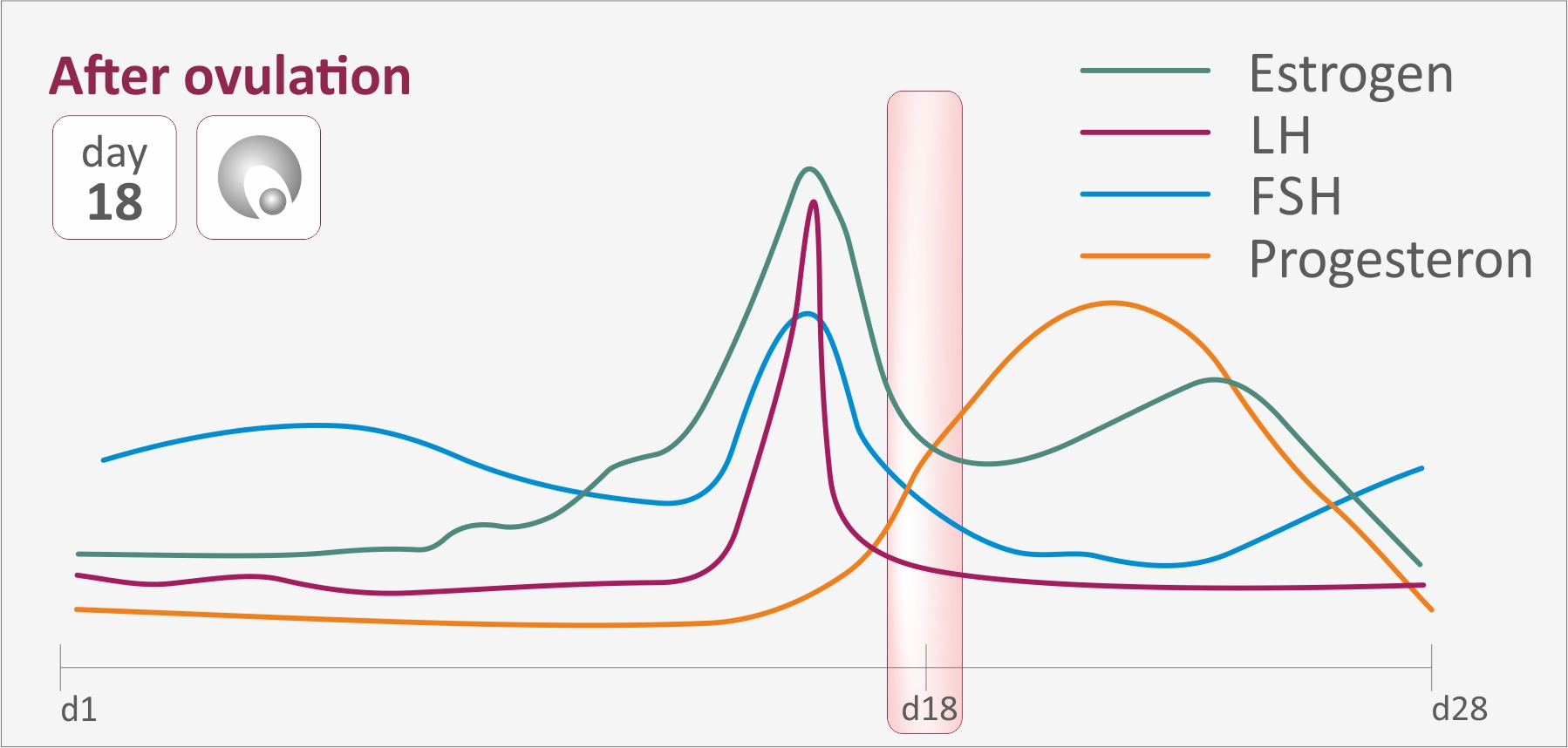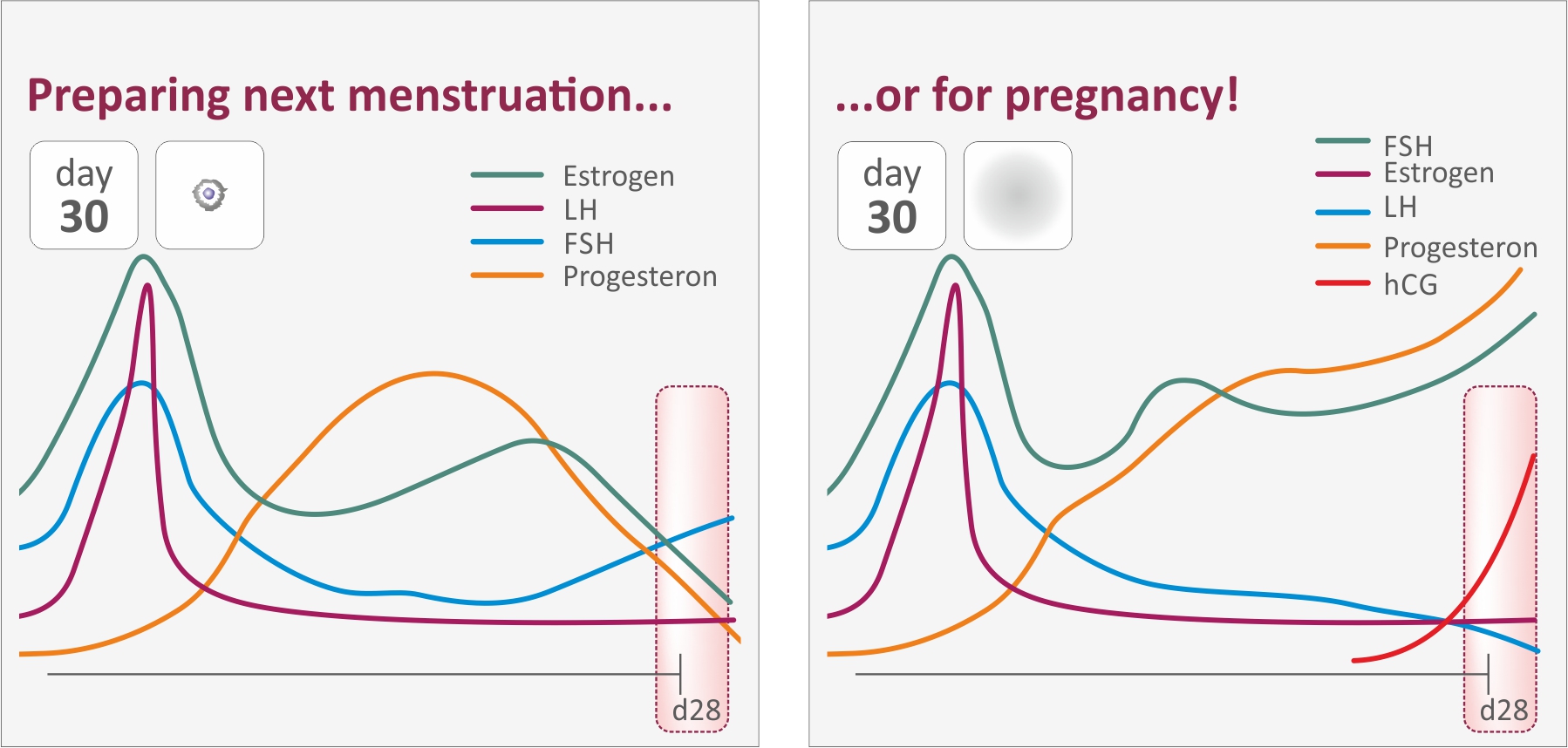The menstrual cycle and ovulation
A normal menstrual cycle is the best indicator of good general health.
The menstrual cycle is the series of monthly changes in a woman’s body, occurring so as to prepare her for pregnancy.
Every month, one of the ovaries releases an egg. This process is called ovulation. At the same time, a series of hormonal changes prepare the uterus for pregnancy. If ovulation occurred, but the egg was not fertilised, the mucous membrane of the uterus (the endometrium) is shed through the vagina. This process is called menstruation.
The menstrual cycle is the period between the first day of menstruation and the first day of the next menstrual period.
Although the average duration of the menstrual cycle which is considered normal is 28 days, only 15% of women have such a cycle. The length of the menstrual cycle varies from one woman to another, most frequently between 23 and 35 days.
Changes that affect the duration of the menstrual cycle most likely occur during the follicular phase, i.e. before ovulation. For most women, the luteal phase, namely the period between ovulation and menstruation, lasts between 12 and 16 days.
The monthly bleeding phenomenon is called menstruation, and the discharged blood and tissue are called menses. Usually, menstruation lasts between 3 and 7 days. A few days before menstruation, women often have premenstrual symptoms, and menstrual pains usually occur during the first few days of menstruation. This is due to the fact that the hormones cause the uterus to contract and shed the uterine lining formed during the previous menstrual cycle.
From the moment when menstruation begins, the hormonal system starts working. At first, the pituitary gland in the brain begins to produce follicle-stimulating hormone (FSH). This is the main hormone that stimulates the ovaries to produce mature eggs. In the ovaries, undeveloped eggs can be found in tiny sacks filled with liquid, called follicles. FSH stimulates about 15-20 eggs to develop and start producing oestrogen. The oestrogen level is at its lowest on the first day of the menstrual cycle and begins to rise as the follicles develop.

Approximately on the fifth day of the cycle (or as soon as menstruation ends), the pituitary gland begins to secrete a small amount of luteinising hormone (LH). This is the hormone responsible for the release of the egg and the one identified by ovulation tests, which, when the second line appears, show that ovulation has taken place.
Once the follicles begin to develop, one of them normally becomes dominant, and the egg contained inside reaches maturity, while the other follicles disappear. At the same time, the increasing amount of oestrogen in the body ensures the thickening of the endometrium with nutrients and blood, which is necessary to provide the fertilised egg with all the nutrients and support it needs to grow, in the event when fertilisation and implantation occur.
High levels of oestrogen are also associated with the appearance of the first signs of fertility: fertile cervical mucus, which creates a supportive environment for sperm advancement, is getting increasingly wetter and more abundant as ovulation approaches. You may notice this as a thin, slippery, whitish discharge. Sperm can swim more easily through this mucus and can survive in this environment for several days. The cervix also undergoes some specific changes under the influence of oestrogen, and as ovulation approaches, the cervix goes up, opens and becomes softer.
The oestrogen level is still rising and, when it reaches the maximum amount, it causes a quick increase of the LH, which makes the dominant follicle break and release the mature egg from the ovary into the Fallopian tube. This process is known as ovulation and the follicular phase ends here. Usually, only one egg is released during each cycle. This egg is available for fertilisation for 12 to 24 hours. Ovulation occurs alternately between the two ovaries, and ovulation may occur even if menstruation has not occurred. During ovulation you may experience spotting.

Many women believe that ovulation occurs on the 14th day, but this figure is an average, and most women will ovulate on another day of the menstrual cycle. The day of ovulation may also vary from one cycle to another. Some women experience pain or cramps during ovulation, while others feel no sensation and show no other symptoms.
If you have an irregular menstrual cycle, an ovulation test can help you find out when ovulation occurs. These tests assess the level of luteinising hormone (LH) in urine and are available in pharmacies without a prescription.
Once released, the egg moves through the Fallopian tube to the uterus. From this moment on, the luteal phase begins.
The egg can live up to 24 hours. Sperm cells survive longer, usually between 3 and 5 days, so the days before ovulation and the day of this process are the most fertile ones. As soon as ovulation has taken place, FSH levels decline suddenly and, under the action of LH, the follicle begins to produce another hormone: progesterone. Progesterone determines the further thickening of the endometrium, preparing the uterus for a fertilised egg.
Meanwhile, the empty follicle in the ovary is getting smaller; it turns into corpus luteum (or yellow body) and continues to produce progesterone. It also begins to produce oestrogen to help prepare the endometrium for a possible pregnancy. During this phase, you may experience premenstrual syndrome (PMS) symptoms, such as increased breast tenderness, bloating, lethargy, depression and irritability. Progesterone also determines the basal body temperature increase.
If the egg has not been fertilised, oestrogen and progesterone levels decline. Without the hormones that helped maintain it, the thickened uterine lining breaks down and the body will eliminate it. This is the beginning of menstruation and the following cycle.
If it has been fertilised, the egg can successfully implant itself in the endometrium around a week after fertilisation. As soon as the fertilised egg has implanted itself, the body begins to produce the pregnancy hormone, human chorionic gonadotropin (hCG), which will keep the corpus luteum active. hCG is the hormone identified by pregnancy tests and the much-awaited second line only appears when this hormone is present.

In the post-ovulatory period, eat healthy, release yourself from tension and
look for ways to relax, so as to support the successful implantation
of the fertilised egg in the endometrium.

Preparing for the next menstruation…
As the empty follicle becomes smaller, if the egg has not been fertilised, oestrogen and progesterone levels decline. Without the hormones that helped maintain it, the thickened uterine lining breaks down and the body will eliminate it. This is the beginning of menstruation and the following cycle.
…or for pregnancy
If the egg has been fertilised, it can successfully implant itself in the endometrium. This usually occurs around a week after fertilisation. As soon as the fertilised egg has implanted itself, the body begins to produce the pregnancy hormone, human chorionic gonadotropin (hCG), which will keep the corpus luteum active. It continues to produce oestrogen and progesterone to prevent the shedding of the endometrium until 12 weeks, when the placenta is mature enough to maintain the pregnancy.